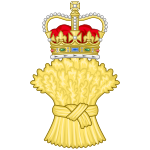 The heraldic badge of Chester Herald of Arms in Ordinary | |
| Heraldic tradition | Gallo-British |
|---|---|
| Jurisdiction | England, Wales and Northern Ireland |
| Governing body | College of Arms |
Chester Herald of Arms in Ordinary is an officer of arms at the College of Arms in London. The office of Chester Herald dates from the 14th century, and it is reputed that the holder was herald to Edward the Black Prince. In the reign of King Richard II the officer was attached to the Principality of Chester, which was a perquisite of the then Prince of Wales. In the reign of King Henry VIII the title lapsed for a time but, since 1525, the office of Chester has been one of unbroken succession, as a herald in ordinary. The badge of office is taken from the arms of the Earl of Chester and in blazoned as A Garb ensigned of the Royal Crown Or.
Contents
The current Chester Herald of Arms is Dominic Ingram.




































